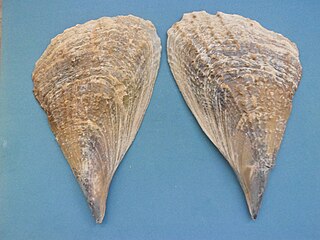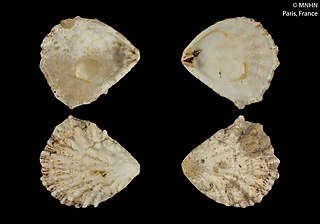
Ark clam is the common name for a family of small to large-sized saltwater clams or marine bivalve molluscs in the family Arcidae. Ark clams vary both in shape and size. They number about 200 species worldwide.

Barbatia is a genus of "bearded" ark clams, marine bivalve mollusks in the family Arcidae, the ark clams.

The Plicatulidae are a family of saltwater clams, marine bivalve mollusks, known commonly as kitten's paws or kittenpaws. These bivalves are related to oysters and scallops. The family has a single living genus, Plicatula, with a second, Harpax known from fossils.

Chamidae, common name the jewel boxes or jewel box clams, is a taxonomic family of saltwater clams, the marine bivalve mollusks in the order Venerida.

Argopecten is a genus of saltwater clams, or scallops, marine bivalve mollusks in the family Pectinidae.

Arca is a genus of saltwater clams in the family Arcidae, the ark clams.

Arca imbricata, or the Mossy ark clam, is a clam in the family Arcidae. It can be found along the Atlantic coast of North America, ranging from North Carolina to the West Indies, Brazil, and Bermuda.

Barbatia candida, or the White-bearded ark clam, is a clam in the family Arcidae. It can be found along the Atlantic coast of North America, ranging from North Carolina to Texas, including the West Indies.

Barbatia domingensis, or the White miniature ark clam, was for many years a name that was commonly used for a marine clam in the family Arcidae.

Barbatia tenera, or Doc Bales' ark clam, is a clam in the family Arcidae. It can be found along the Atlantic coast of North America, ranging from southern Florida to the West Indies.

Brachidontes is a genus of mussels in the family Mytilidae.

Pteria is a genus of molluscs in the family Pteriidae. The species of the genus are sometimes referred to as wing-oysters or winged oysters.

Atrina seminuda, the half-naked pen shell, is a species of bivalve mollusc in the family Pinnidae.

Plicatula gibbosa, or the Atlantic kitten's paw, is a species of bivalve mollusc in the family Plicatulidae.

Periglypta is a genus of bivalves in the subfamily Venerinae of the family Veneridae.

Acar is a genus of small saltwater clams, marine bivalve mollusks in the family Arcidae, the ark clams.

Pseudochama is a species of bivalve mollusc in the family Chamidae.

















